
Sunrise over Isabela seen from Fernandina

The sun peeks through the clouds over Isabela Island, Fernandina's eastern neighbour, as we get ready for the morning's excursion to Punta Espinosa on Fernandina. Fernandina is the archipelago's youngest island, and is also the most volcanically active. In 1968, Volcan La Cumbre's caldera floor collapsed over 1000 feet, and there have been four lava flow eruptions since, the last being in 1994. This activity and the youth (although we are still talking hundreds of thousands of years) is evident in the unearthly landscape.
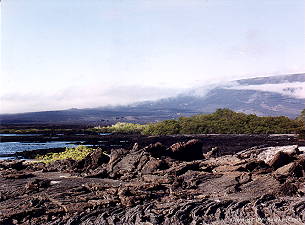 pahoehoe or "ropey" lava field |
 "aa" lava field |
The entire island is covered with frozen lava flows, where vegetation still hasn't taken much of a hold, unlike the previous islands we had encountered. Most of the lava fields are made up of pahoehoe, or "ropey" lava; hundreds of long strands of rock made directly frozen flows. Some of the lava fields are made up of aa lava; rough, shattered pieces of rock formed when there is a large temperature change, in most cases where the lava flow meets water.
Another dramatic example of volcanic activity is where the land itself is uplifted due to subterranean pressure. Punta Espinosa itself was formed by a tectonic uplift in 1975. Striking evidence of its recent birth, is part of an engine from a sunken ship from the early 1900's, now above sea level where the entire beach had been uplifted from the sea floor. Sometimes, such an uplift occurs gradually, but other times it happens in a split second, leaving sea creatures like lobsters and fish stranded on dry land.
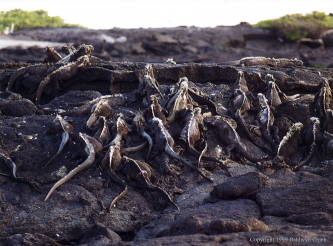
One of the main attractions of Fernandina is the large number of marine iguanas that cover the lava fields. These creatures are much larger than the species we first encountered on Genovesa, up to 2 feet in length. First thing in the morning, they were slow-moving as they sat on the black rocks, absorbing the heat of the sun. The only sea-going lizards in the world, and endemic to the Galápagos, it's not much a leap to see that they evolved from land iguanas who found a rich untapped food source of algae in the sea. Because of all the salt water in their diet, they desalinate by exhaling sharply, blowing salt from their nostrils.
The marine iguanas share a symbiotic relationship with the local Darwin finches and lava lizards. Both the finches and lava lizards feed off of
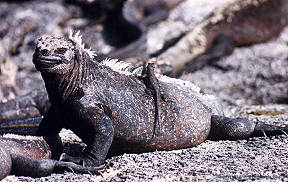 Lava lizard and marine iguana |
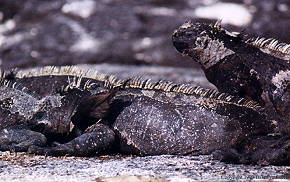 Darwin finch feeding from shedding skin of a marine iguana |
We come across both of the flightless species of Galápagos birds on this island: the flightless comorant, and the Galápagos penguin. The comorant faces no predators, but the island offers little in food, so the bird has traded functional wings for the ability to swim and dive. The result: tiny, vestigial wings that it doesn't even use for swimming. Our first encounter with the penguin is in a small lagoon, where he flies through the water like a torpedo, flapping his wings. The second smallest penguin in the world, these are generally under two feet tall, and can reach speeds of 45 km/hr in the water. Also along the coastline, we find American oyster catchers (where American refers to South America), lava heron, and the great blue heron.
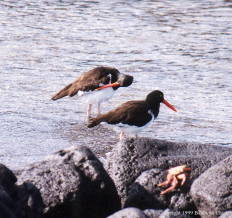 American oyster catchers |
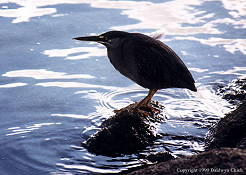 Lava heron in hunting stance |
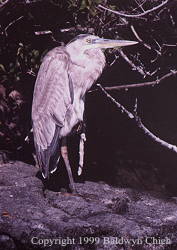 Great blue heron |
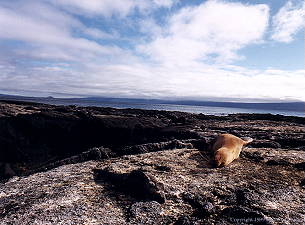 |
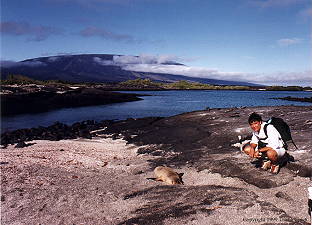 |
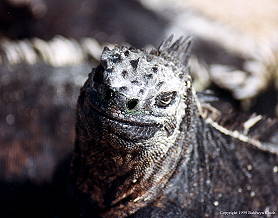
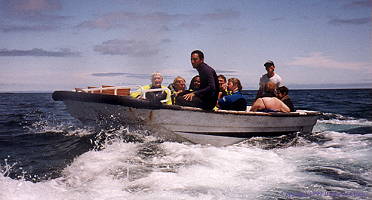
We climb aboard the Flamingo I again to don our wet suits for snorkelling off the panga. Today, we're heading into the coldest waters around the islands, but Renato who admits he's a wuss, says that the opportunity to see marine iguanas feeding underwater is all worth it. It actually wasn't too bad temperature-wise, I was just glad I had a wetsuit on. As the rest of the group hangs together, I come across a pacific green sea turtle swimming beside me. I briefly give chase to snap a picture. I catch up, and Renato points me to a marine iguana feeding. The iguana has extremely sharp teeth that uses to scrape the algae from the rocks. As I try to compose the shot, the iguana lets go of the rock, and swims away, its powerful tail providing all the control and propulsion it needs. Its swimming motions are exactly like the new Godzilla's! (My iguana pictures didn't turn out, by the way).
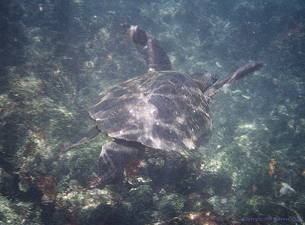
|
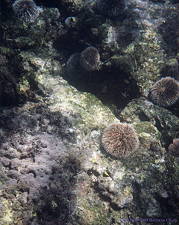
|